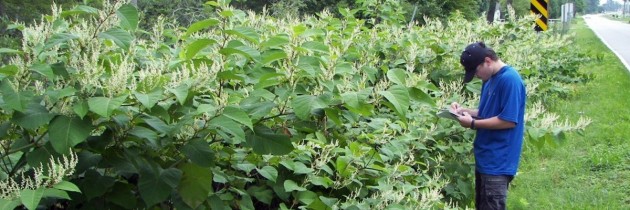Invasive Species Month Here
Taking notes on Japanese Knotweed, – photo courtesy Invasive Species Council of B.C.
Prince George, B.C.- This is Invasive Species month in B.C., and you may be surprised to hear about some of the plants, and creatures that are being introduced to the region.
Gail Wallin, Executive Director of the Invasive Species Council of BC (ISCBC) says people may be surprised to learn some of the invasive species have been introduced by unsuspecting gardeners ” Internationally, over 60% of invasive plant species have come in from landscaping or horticulture.” That holds true in B.C. as well says Wallin ” Actually most invasive plants that we have trouble with have been intentionally planted either in our gardens or in our landscaping. Because when you bring in a plant or a species from someplace else, it doesn’t come with its predators.”
She says most horticulture specialty garden centres are aware of the plants and species that can pose a threat but the Invasive Species Council of BC has been working with some of the big box stores which may not have a Master Gardener or Horticulturalist on hand who would be able to give gardeners advice.
Wallin says there are some plant species that are surfacing in the north that haven’t been seen before “Particularly in the west part of the region, some of the knotweeds are coming in. Knotweeds are ones that have been more historically in the Vacnouver area. They are a bamboo like plant that grows very aggressively and threatens infrastructures, it will actually come through highways foundations etcetera. Another plant that is a concern to the north central area, is mountain bluet. It is a common horticulture plant there.”
There is now a program in B.C. called Plant Wise “It helps gardeners and industry make sure that they are buying and planting plants that are not invasive.”
But it isn’t just plants. With more and more property owners adding ponds to their landscape, she says there is also a concern about Koi, and pond plants that could end up in streams or lakes. As 250 News reported in February of this year, Koi have been spotted in Quesnel’s Dragon Lake,. The Koi could have a negative impact on the trout population in that lake.
One of the programs to be launched during this special month is “Don’t Let it Loose” Wallin says many people dump their aquariums, including school groups of fish, and millfoil a common aquarium plant, into a water system.
“Stopping invasive species is possible if we change our behaviours and take action together,” says Wallin, “Increased prevention, detection and improved management of invasive species can provide significant economic benefits to the province, businesses, industry, and citizens. We are highlighting actions everyone can take each week this month, with easy things you can do to stop invasive species from spreading in the water, in plants and agriculture, through firewood, through sports equipment, and by keeping unwanted pets out of the wild.”
Wallin says everyone can help identify invasive species, “If you see something new along the side of the road, it’s probably a weed, and there is a report a weed app that everyone can put on their phones for free. There are a number of websites, including ours (http://bcinvasives.ca/) where you can find out if that plant is invasive to your region.”


Comments
Sure is too bad that the evasive tent catipillar doesn’t get the same attention. This is the third year that the trees will look like they are in winter. Surrey gets sprayed but as usual the North is ignored. Haw can you possibly attract tourists to the area when it looks like winter but the ski hills are closed!
I’ve seen a few caterpillars in the bowl area, but nothing like we had two years ago. Not very many on the May trees at all.
What I have seen is fewer bees, yellow jackets and hornets.
Big deal . Worms ? Worms you can spray and kill the little ( expletive ) . I’ve got thirty years into growing filberts ( hazelnuts ) . the eastern filbert blight is coming . My filberts could have live and produced hundreds of pounds per year for another thirty years . It’s not here yet but when it comes it will likely whipe out the wild ones as well . The filberts in Langley and Agassi have been desemated . That’s where the largest production in canada is /was . No help from Chrissy as usual . Looks like a bumper crop again this year . No sign of the blight yet . When your trees get it , they will be stone dead .
Comments for this article are closed.